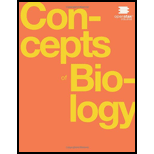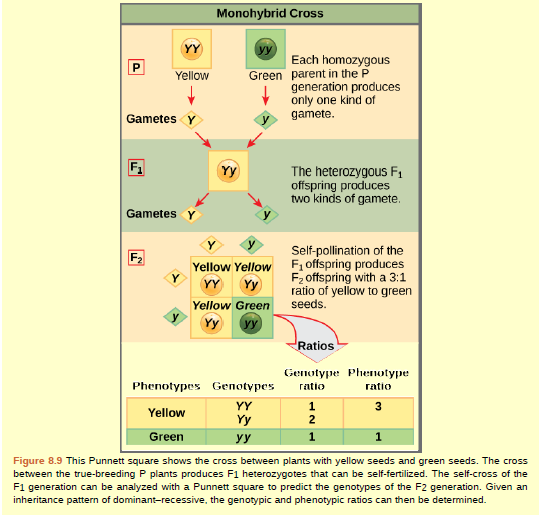
Concept explainers
Figure 8.9 In pea plants, round peas (R) are dominant to wrinkled peas (r). You do a test cross between a pea plant with wrinkled peas (genotype rr) and a plant of unknown genotype that has round peas. You end up with three plants, all which have round peas. From this data, can you tell if the parent plant is homozygous dominant or heterozygous?

To analyze:
If the parent plant is homozygous dominant or heterozygous.
Introduction:
An organism is known as homozygous dominant when it carries two copies of same dominant allele and when it carries two copies of the same recessive allele, then it is called as homozygous recessive. In case of heterozygous organisms, two different alleles of a gene are present.
Explanation of Solution
Given:

According to the figure, Punnet square depicts the cross between plants with yellow and green seeds. There is a cross between the true-breeding parent (P) plantswhich produce F1 heterozygotes and are capable of self-fertilization. This self-cross of the F1 generation can be used for analysis with the Punnet square for predicting the genotype of the F2 generation. If the inheritance pattern of the dominant and recessive is provided then, the genotypic and phenotypic ratios can be determined.
Here, the pea plants having round peas(R) are dominant to the wrinkled peas(r). A test cross between a pea plant with the wrinkled peas having genotype (rr) and an unknown genotype having round peas. The progenyhas three plants with round peas. From this data,it cannot be surely concluded if the given plant is homozygous or heterozygous because the data set given is quite small. Due to a random chance, the three plants have acquired the dominant gene only even if the recessive gene is present.
Thus,from this data, we can't conclude if the given plant is homozygous or heterozygous because the data set given is quite small.
Want to see more full solutions like this?
Chapter 8 Solutions
Concepts of Biology
Additional Science Textbook Solutions
College Physics
Biology: Life on Earth (11th Edition)
Human Anatomy & Physiology
Human Anatomy & Physiology (2nd Edition)
Human Physiology: An Integrated Approach (8th Edition)
Microbiology: An Introduction
- Imagine that you are performing a cross involving seed color in garden pea plants. What traits would you expect to observe in the F1 offspring if you cross true-breeding parents with green seeds and yellow seeds? Yellow seed color is dominant over green. a. only yellow-green seeds b. only yellow seeds c. 1:1 yellow seeds:green seeds d. 1:3 green seeds:yellow seedsarrow_forwardFigure 12.5 In pea plants, round peas (R) are dominant to wrinkled peas (r). You do a test cross between a pea plant with wrinkled peas (genotype rr) and a plant of unknown genotype that has round peas. You end up with three plants, all which have round peas. From this data, can you tell if the round pea parent plant is homozygous dominant or heterozygous? If the round pea parent plant is heterozygous, what is the probability that a random sample of 3 progeny peas will all be round?arrow_forwardYou want to determine whether genes a and b are linked. What cross would you use and why? How would this cross tell you if they are linked?arrow_forward
- Imagine you are crossing two plants that have these two genotypes—Tt and tt. What are the two genotypes of the gametes that the Tt plant can make? What is the one genotype of the gametes that the tt plant can make? Set up a Punnett square to analyze the cross. Does the Punnett square need to have four boxes or just two? If you were crossing a TT plant with a tt plant, how many boxes would be necessary in a Punnett square?arrow_forwardIn a certain type of pea plant, the gene for yellow color (Y) is dominant to the gene for green color (y), and the gene for round shape (R) is dominant to the gene for wrinkled shape (r). If a homozygous dominant plant is mated with a homozygous recessive plant (P-gen), what proportion in the F2 generation will be homozygous recessive? a) 1/4 b) 1/16 c) 3/4 d) 3/8arrow_forwardin a certain plant, when individuals with blue flowers are crossed with individuals with blue flowers, only blue flowers are produced. plants with red flowers crossed with plants with red flowers sometimes produce only red flowers, although other times they produce either red or blue flowers. when plants with red flowers are crossed with plants with blue flowers, sometimes only red flowers are produced; other times either red or blue flowers are produced. which of the following is true? Red is incompletely dominant Red is recessive Red is dominant Red is codominant Blue is dominantarrow_forward
- In a test cross, an individual dominant for a certain trait ( whether homozygous or heterozygous is unknown) is crossed with a homozygous recessive individual. A plant with spherical seeds is crossed with another plant. If the genotypes and phenotypes of the offspring are 100% heterozygous and 100% dominant, what were the genotypes of the parents? (hint: try multiple crosses until you find what works) If the genotypes and phenotypes of the offspring are 50% heterozygous spherical seeds and 50% wrinkled seeds, what were the genotypes of the parents?arrow_forwardImagine you are performing a cross involving gerden pea plants. What F1 offspring would you expect if you cross plants with green seedsand plants that are homozygous for the yellow seed colo allele? -yellow seed is dominant over green 100 percent yellow - green sedds 100 percent yellow seeds 50 percent yellow, 50 percent green seeds 25 percent green, 75 percent yellow seedsarrow_forwardIn wild sunflowers, populations occurs that are either yellow or white. one variety of true breeding white flowered plants was crossed to another pure strain of white flowered plants. the resulting F1 progeny were yellow flowered plants. When the F1 progeny were intercrossed, the offspring were 56 yellow flowers and 44 white flowers. From these results, how many genes control the flower color? Is any one gene epistatic to any other gene?arrow_forward
- Bateson and Punnett crossed two white-flowered lines and saw all purple flowers in the F1 generation. They concluded this was an example of complementary gene interactions because a cross of the F1 plants yielded what ratio in the F2 generation? A) 8 purple to 8 white B) 16 purple to 0 white C) 0 purple to 16 white D) 7 purple to 9 white E) 9 purple to 7 whitearrow_forwardIn Figure 5-15, how are each of the following genotypesproduced?a. F+ a− c. F− a+b. F− a− d. F+ a+arrow_forwardImagine you are performing a cross involving seed color in garden pea plants. What F1 offspring would you expect if you cross true-breeding parents with green seeds and yellow seeds? Yellow seed color is dominant over green. a. 100 percent yellow-green seeds b. 100 percent yellow seeds c. 50 percent yellow, 50 percent green seeds d. 25 percent green, 75 percent yellow seedsarrow_forward
 Concepts of BiologyBiologyISBN:9781938168116Author:Samantha Fowler, Rebecca Roush, James WisePublisher:OpenStax College
Concepts of BiologyBiologyISBN:9781938168116Author:Samantha Fowler, Rebecca Roush, James WisePublisher:OpenStax College Biology 2eBiologyISBN:9781947172517Author:Matthew Douglas, Jung Choi, Mary Ann ClarkPublisher:OpenStax
Biology 2eBiologyISBN:9781947172517Author:Matthew Douglas, Jung Choi, Mary Ann ClarkPublisher:OpenStax Biology: The Dynamic Science (MindTap Course List)BiologyISBN:9781305389892Author:Peter J. Russell, Paul E. Hertz, Beverly McMillanPublisher:Cengage Learning
Biology: The Dynamic Science (MindTap Course List)BiologyISBN:9781305389892Author:Peter J. Russell, Paul E. Hertz, Beverly McMillanPublisher:Cengage Learning


